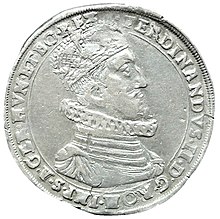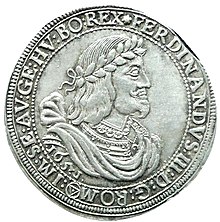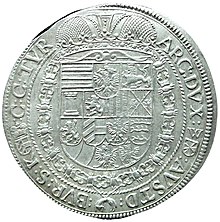Austrian thaler
Austrian crowns are the 1566-1750 in the Habsburg hereditary lands pronounced Austria by their own laws Taler whose meal and grain compared to the Reichstalern was lower.
Emperor Maximilian II approved the thaler as Reichstaler with the Augsburg Reichs Farewell on May 30, 1566, minted with 8 pieces from the rough mark, each piece of 14 lot of 4 Grän silver (29.232 g) and thus 9 pieces from the fine mark , Fine weight 25.984 g. According to Emperor Ferdinand's tasting regulations of August 20, 1559, a remedy of only 1 grän for one mark was permitted for the silver varieties. There could be no deviations in the shot of the thaler.
The Princes of Tyrol and Styria refused acceptance of the coinage system, and the stands in Bohemia had concerns because of the out of the monetary standard resulting silver price was too low for their mines. Maximilian II therefore re-enacted the imperial edict of Emperor Ferdinand I from 1524 for all Austrian countries, which allowed a lower fine weight of 25.87 g. The Habsburg hereditary lands had received from Emperor Charles V with the patent in Madrid on 10 March 1525 the privilege of being able to modify existing monetary laws as required and new publicize. Maximilian II made use of this right.
After the tipper and wipper era , the fine weight of the thaler, which was minted in the Austrian states, was further reduced in 1623 and then in 1659.
When all the coins in circulation were tested in 1738, the Kreismünzwardeine found the small amount of shot and grain of the thalers minted in the Austrian countries with the emperor's portrait of Leopold, Joseph and Karl VI. also noted.
| Valleys | Reichstaler | Thaler from 1623 | Thaler from 1659 | 1668 to 1705 | 1706 to 1711 | 1712-1737 |
|---|---|---|---|---|---|---|
| Emperor: | Ferdinand III. | Leopold I. | Leopold I. | Joseph I. | Charles VI | |
| Pieces from the rough marrow: | 8th | 8 1/8 | 8 1/8 | 8 1/5 | 8 1/5 | 8 1/8 |
| Gross weight: | 29.232 g | 28.819 g | 28.815 g | 28.519 g | 28.519 g | 28.782 g |
| Salary: | 14 Lot 4 Grän | 14 Lot 4.5 Grän | 14 lot | 14 lot | 14 Lot 1 Grän | 14 Lot 1 Grän |
| 888.889 ‰ | 890.625 ‰ | 875,000 ‰ | 875,000 ‰ | 878.472 ‰ | 878.472 ‰ | |
| Pieces from the fine marrow: | 9 | 9.11 | 9.28 | 9.37 | 9.33 | 9.25 |
| Fine weight: | 25.984 g | 25.667 g | 25.214 g | 24,954 g | 25.053 g | 25.284 g |
The monetary value of the fine mark was between 18 guilders 29 kreuzers and 18 guilders 44 kreuzers when the Austrian thaler was issued from 1700 onwards . This enabled the Austrian thalers to hold their own against the emerging Leipzig 20 gulden coinage rate . Mint in the mints of the Habsburg hereditary lands:
| year | Valleys | Ducats |
| 1724 | 272,384 pieces | 103,905 pieces |
| 1730 | 422,850 pieces | 177,147 pieces |
| 1738 | 710,615 pieces | 885,095 pieces |
When the convention foot was introduced , the lower fineness of the Austrian thaler was taken into account in that they were valued at 1 thaler 10 groschen and thus 1 groschen less than, for example, the Saxon Reichstaler.
- Austrian thaler 1620 Emperor Ferdinand II. Archduchy of Austria
- Mint Vienna, mint master Matthias Fellner von Feldegg in office 1612–1617 and 1619–1659
- Weight actual: 27.31 g diameter: 43.71-44.73 mm thickness: 2.04 mm / edge smooth
- Obv .: Half-length portrait of the emperor with the imperial crown in a collar with a large ruff (millstone collar) to the right; underneath in the inscription mint mark W, title inscription bordered by a decorative circle, beginning at the top after the crown: FERDINANDUS II DEI GRATIA ROMANORUM IMPERATOR SEMPER AUGUSTUS GERMANIAE HUNGARIAE ET BOHEMIAE REX = Ferdinand II by God's grace Roman emperor, at all times a member of the empire, king in Germania , Hungary and Bohemia
- Back: Rounded coat of arms at the bottom with multi-panel prince's coat of arms under the imperial crown, surrounded by a chain of orders of the Golden Fleece with a ram's skin; underneath in the inscription Münzstättenzeichen coat of arms shield with coat of arms of the city of Vienna (cross); year, separated by a crown in the legend; Continuation of the title inscription after Krone, bounded by the pearl circle: ARCHIDUX AUSTRIAE DUX BURGUNDIAE ETC = Archduke of Austria, Duke of Carinthia, Duke of Burgundy etc.
- Austrian thaler 1651 Emperor Ferdinand III. Archduchy of Austria
- Mint Vienna mint master Johann Konrad Richthausen (from 1653 Baron von Chaos) in office 1648–1659
- Weight Actual: 27.31 g Diameter: 44.55-46.28 mm Thickness: 1.91 mm / smooth edge
- Obv .: Half-length portrait of the emperor with a goatee and laurel wreath in an antique armor with a field band, a chain of golden fleece and a ram's skin, on the arm section the year with dots after each digit; underneath in the inscription mint master's mark (triangle with dot in a circle), title inscription bordered by a pearl circle, beginning at the top after a stylized flower: FERDINANDUS III DEI GRATIA ROMANORUM IMPERATOR SEMPER AUGUSTUS GERMANIAE HUNGARIAE BOHEMIAE REX = Ferdinand III. By God's grace Roman emperors, at all times multiples of the empire, king in Germania, Hungary and Bohemia
- Rev .: at the bottom a rounded heraldic shield with multi-field prince's coat of arms under the imperial crown, surrounded by a chain of orders of the Golden Fleece with a ram's skin; in the inscription, on the left, the coat of arms is divided up (binding shield and Burgundy) and on the right, the mint mark W above the coat of arms with the coat of arms of the city of Vienna (cross); Continuation of the title inscription after Krone, bounded by Perlkreis: ARC: DVX: AVST D: BVR: S: K: C: C: TYR [colon is missing between AVST and D] = ARCHIDUX AUSTRIAE DUX BURGUNDIAE STYRIÆ CARINTHIÆ CRAIN COMES TYROLIS = Archduke of Austria , Duke of Burgundy, Styria, Carinthia, and Krayn, Count of Tyrol
- Austrian thaler 1705 inaugural thaler Emperor Joseph I. Archduchy of Austria
- Minted 1705–1711 Vienna Mint, mint master Matthias Mittermayer von Waffenberg (1679–1708),
coin cutter Johann Michael Hoffmann (1680–1736), reverse coinage - Weight: 28.56 g Diameter: 44.26-44.55 mm Thickness: 2.42 mm / link chain edge
- Obv .: large bust of the emperor with an allonge wig in antique armor with a chain of golden fleece and golden ram's skin, the artist's
signature MH in the fold of the overturned cloak . Title inscription: IOSEPHUS DEI GRATIA ROMANORUM IMPERATOR SEMPER AUGUSTUS GERMANIAE HUNGARIAE BOHEMIAE REX = Josephus Emperor of God , at all times a member of the empire, king in Germania, Hungary and Bohemia - Rev .: Nimbed double-headed eagle under a floating imperial crown, in the claws sword and scepter, on the chest crowned, highly divided coat of arms (shield and Burgundy), surrounded by a chain of golden fleece; Title inscription continued: ARCHIDUX AUSTRIAE DUX BURGUNDIAE COMES TYROLIS = Archduke of Austria, Duke of Burgundy, Count of Tyrol
- Minted 1705–1711 Vienna Mint, mint master Matthias Mittermayer von Waffenberg (1679–1708),
- Austrian thaler 1712 inaugural thaler Karl VI. Archduchy of Austria
- Mint 1712–1718 Vienna Mint Mint master Franz Joseph Mittermayer von Waffenberg (1709–1726) Coin cutter Johann Michael Hoffmann (1680–1736), reverse coinage
- Weight: 28.51 g Diameter: 43.16-43.55 mm Thickness: 2.43 mm / leaf edge
- Obv .: large bust of the emperor with an allonge wig in an antique splendid armor with a chain of golden fleece and golden ram's skin, the artist's
signature MH in the fold of the overturned coat. Title inscription: CAROLUS VI DEI GRATIA ROMANORUM IMPERATOR SEMPER AUGUSTUS GERMANIAE HISPANIAE = Karl VIARIAE BOHEMIAE. By God's grace Roman emperors, at all times multiples of the empire, king in Germania, Spain, Hungary and Bohemia - Rev .: Nimbed double-headed eagle under a floating imperial crown, in the claws sword and scepter, on the chest crowned, highly divided coat of arms (shield and Burgundy), surrounded by a chain of golden fleece; Title inscription continued: ARCHIDUX AUSTRIAE DUX BURGUNDIAE COMES TYROLIS = Archduke of Austria, Duke of Burgundy, Count of Tyrol
- Austrian thaler 1721 Karl VI. Princely county of Tyrol
- Minted 1715–1721, 1724, 1725 Hall Mint, reverse coinage
- Weight: 28.52 g Diameter: 42.98-43.19 mm Thickness: 2.11 mm / smooth edge
- Obv .:
Half-length portrait of the emperor with an allonge wig and laurel wreath in an antique splendid armor with a chain of golden fleece and golden ram's skin. By God's grace Roman emperors, at all times multiples of the empire, king in Germania, Spain, Hungary and Bohemia - Rev .: Nimbered double-headed eagle under a floating imperial crown, sword and scepter in the claws, crowned four-part heraldic shield with the coats of arms of Burgau, Hungary, Bohemia and Burgundy and a crowned heart shield with the eagle coat of arms of Tyrol, surrounded by a chain of the Golden Fleece; Title inscription continued: ARCHIDUX AUSTRIAE DUX BURGUNDIAE COMES TYROLIS = Archduke of Austria, Duke of Burgundy, Count of Tyrol
Individual evidence
- ^ Siegfried Becher: Das Österreichische Münzwesen from 1524 to 1838. Volume 1, Section 2, Vienna 1838, p. 4.
- ^ Herbert Rittmann: Deutsche Geldgeschichte 1484-1914. Battenberg 1975, pp. 206f.
- ^ Siegfried Becher: The Austrian coinage from the years 1524 to 1838. 1st volume, 2nd section, Vienna 1838, p. 21.
- ^ Wilhelm Zich: The Vienna Coin Contract of January 24, 1857. and Carl Ludwig von Bruck, dissertation at the University of Vienna, August 2009, p. 3f.
- ^ Johann Christoph Stößel: Attempt at a Chur-Saxon coin history. Chemnitz 1780, p. 798.
- ^ Siegfried Becher: The Austrian coinage from 1524 to 1838. Volume 1, Section 2, Vienna 1838, p. 31.
- ^ Siegfried Becher: Das Österreichische Münzwesen from 1524 to 1838. Volume 1, Department 1, Vienna 1838, pp. 181f.
- ^ Johann Christoph Stößel: Attempt at a Chur-Saxon coin history. Chemnitz 1780, p. 798.
- ^ Gerhard Schön: German coin catalog 18th century 1700–1806. 4th edition. 2008, p. 701f. No. 9
- ^ Gerhard Schön: German coin catalog 18th century 1700–1806. 4th edition. 2008, p. 701ff. No. 20
- ^ Gerhard Schön: German coin catalog 18th century 1700–1806. 4th edition. 2008, p. 1080f. No. 20.











